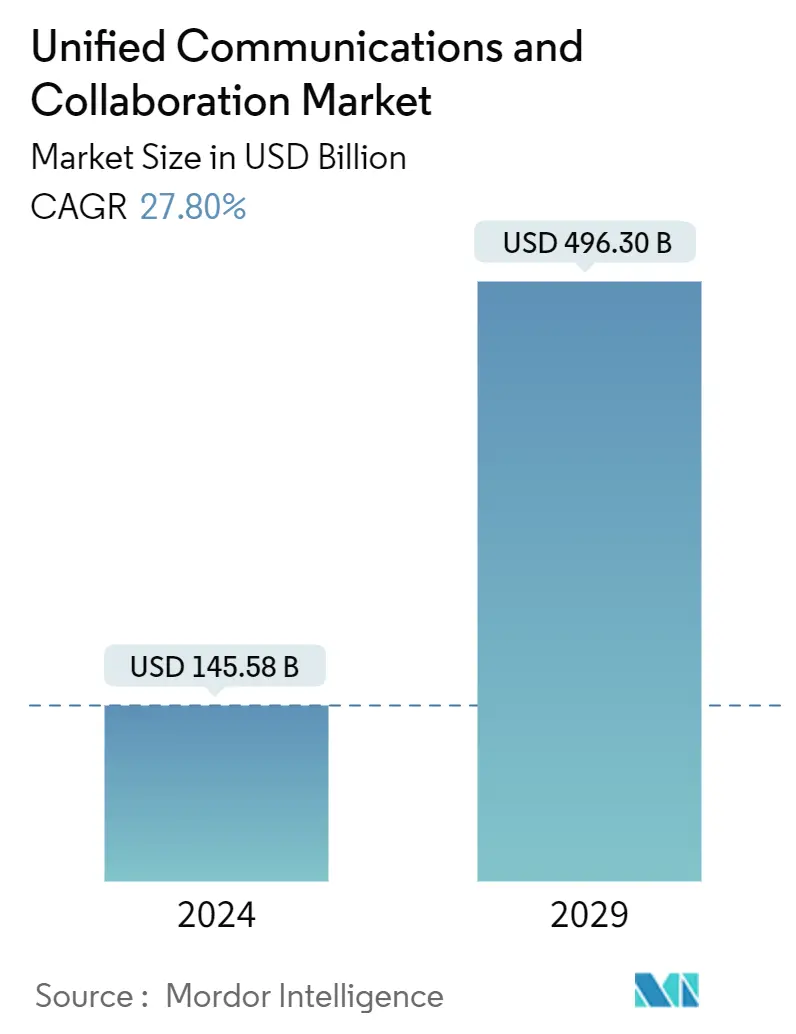Market Size of Unified Communications And Collaboration Industry

| Study Period | 2019 - 2029 |
| Market Size (2024) | USD 145.58 Billion |
| Market Size (2029) | USD 496.30 Billion |
| CAGR (2024 - 2029) | 27.80 % |
| Fastest Growing Market | Asia Pacific |
| Largest Market | North America |
Major Players
*Disclaimer: Major Players sorted in no particular order |
Unified Communications and Collaboration Market Analysis
The Unified Communications And Collaboration Market size is estimated at USD 145.58 billion in 2024, and is expected to reach USD 496.30 billion by 2029, growing at a CAGR of 27.80% during the forecast period (2024-2029).
Traditionally, demand for unified communication and collaboration has been dominated by single products. Businesses used to select their own products for particular needs. For example, organizations bought email servers for messaging, team rooms for teamwork, portals for organizational information sharing, and PBX and voicemail for telephony services. Customers are making strategic technology decisions to deploy unified communications and collaboration environments based on the entire collaboration stack's capability, richness, and integration.
- Companies that choose collaboration and communication products often do so based on the platform's future direction. Selecting the right platform helps companies reduce IT costs, management overhead, and integration challenges. Moreover, a holistic platform approach substantially benefits end-user training, adoption, and business value.
- The advent of cost-effective cloud-based solutions has increased healthcare providers' adoption, often categorized as having minimum IT budgets. With the subscription-based united communication services, the healthcare contact centers establish their PBX (Private Branch Exchange) systems and seamlessly address multiple customer requests from various sites.
- Various individual and B2B data-intensive applications, such as AR, VR, and video applications, are emerging. The industries such as IT, telecom, BFSI, healthcare, retail, media and entertainment, and many others have different types of video conferencing essentials, including high bandwidth, low power, ultra power latency, and high speed.
- Remote work mandates create an unprecedented opportunity for service providers to promote software-based communications as a critical enabler of business continuity and demonstrate the flexibility of unified communications as a service (UCaaS) and cloud services regarding capacity adjustments and service delivery (irrespective of location). This trend is expected to support market growth.
- The high installation costs of UCC systems are one of the greatest problems SMEs confront. Integration of multiple communication channels onto a single platform necessitates substantial investments in infrastructure, software, and hardware.
- The COVID-19 pandemic hastened the transition to remote work, compelling businesses and organizations to adopt virtual collaboration tools to ensure business continuity. Demand for video conferencing, instant messaging, and other communication and collaboration technologies has skyrocketed as more employees work from home
Unified Communications and Collaboration Industry Segmentation
Unified Communications and Collaboration (UC&C) is a group of solutions organizations implement to ensure that nearly all their technology works smoothly and securely for near real-time collaboration. It is beneficial to integrate multiple enterprise communication tools such as voice calling, video conferencing, instant messaging (IM), presence, content sharing, etc.
unified communications market is segmented by deployment type (on-premise/hosted, cloud), type (business VOIP/UC solutions, enterprise collaboration, contact center services, customer interaction applications), end-user vertical (retail, BFSI, healthcare, public sector) and geography (North America, Europe, Asia-Pacific, Rest of the World (Latin America and Middle East & Africa). The market size and forecasts are provided in terms of value (USD) for all the above segments.
| By Deployment Type | |
| On-premise/Hosted | |
| Cloud (UCaaS) |
| By Type | |
| Business VOIP/UC Solutions | |
| Enterprise Collaboration | |
| Contact Center Services | |
| Customer Interaction Applications | |
| Other Types |
| By End-User Industry | |
| Retail | |
| BFSI | |
| Healthcare | |
| Public Sector | |
| Others End User Industries (Logistics, IT & Telecom, Etc.) |
| By Geography | |
| North America | |
| Europe | |
| Asia-Pacific | |
| Rest of the World (Latin America and Middle East & Africa) |
Unified Communications And Collaboration Market Size Summary
The Unified Communications and Collaboration (UC&C) market is experiencing significant growth, driven by the increasing demand for integrated communication solutions that enhance business efficiency and reduce operational costs. Traditionally, businesses relied on separate products for communication needs, but there is a growing trend towards adopting comprehensive platforms that offer seamless integration and rich capabilities. This shift is largely influenced by the need for cost-effective solutions, particularly in sectors like healthcare, where budget constraints are common. The rise of cloud-based services has further facilitated this transition, enabling organizations to implement subscription-based models that streamline communication processes across multiple locations. The COVID-19 pandemic has accelerated this trend, as remote work mandates have underscored the importance of robust virtual collaboration tools to maintain business continuity.
The UC&C market is characterized by rapid innovation and consolidation, with major players like Microsoft, Cisco, and IBM leading the charge in developing advanced solutions. North America, with its high concentration of businesses and emphasis on technological innovation, remains a key region for market growth. The demand for UC&C solutions is fueled by the need for enhanced productivity, cost reduction, and improved customer engagement across various industries, including IT, telecom, BFSI, healthcare, and retail. As companies increasingly recognize the value of integrated communication tools, the market is poised for continued expansion, with significant investments in research and development aimed at meeting evolving business needs. The market's trajectory is further supported by strategic acquisitions and partnerships, as companies seek to strengthen their offerings and expand their customer base in an increasingly digital and collaborative world.
Unified Communications And Collaboration Market Size - Table of Contents
-
1. MARKET INSIGHTS
-
1.1 Market Overview
-
1.2 Industry Attractiveness - Porter's Five Forces Analysis
-
1.2.1 Bargaining Power of Consumers
-
1.2.2 Bargaining Power of Suppliers
-
1.2.3 Threat of New Entrants
-
1.2.4 Threat of Substitute Products
-
1.2.5 Intensity of Competitive Rivalry
-
-
1.3 Assessment of COVID-19 on the Industry
-
-
2. MARKET SEGMENTATION
-
2.1 By Deployment Type
-
2.1.1 On-premise/Hosted
-
2.1.2 Cloud (UCaaS)
-
-
2.2 By Type
-
2.2.1 Business VOIP/UC Solutions
-
2.2.2 Enterprise Collaboration
-
2.2.3 Contact Center Services
-
2.2.4 Customer Interaction Applications
-
2.2.5 Other Types
-
-
2.3 By End-User Industry
-
2.3.1 Retail
-
2.3.2 BFSI
-
2.3.3 Healthcare
-
2.3.4 Public Sector
-
2.3.5 Others End User Industries (Logistics, IT & Telecom, Etc.)
-
-
2.4 By Geography
-
2.4.1 North America
-
2.4.2 Europe
-
2.4.3 Asia-Pacific
-
2.4.4 Rest of the World (Latin America and Middle East & Africa)
-
-
Unified Communications And Collaboration Market Size FAQs
How big is the Unified Communications And Collaboration Market?
The Unified Communications And Collaboration Market size is expected to reach USD 145.58 billion in 2024 and grow at a CAGR of 27.80% to reach USD 496.30 billion by 2029.
What is the current Unified Communications And Collaboration Market size?
In 2024, the Unified Communications And Collaboration Market size is expected to reach USD 145.58 billion.

